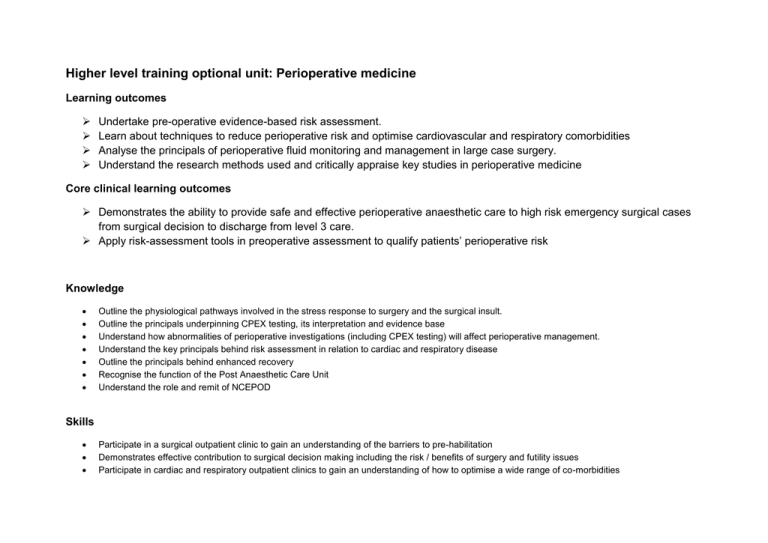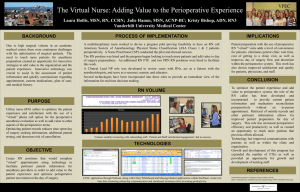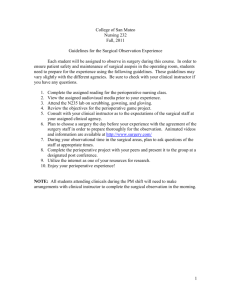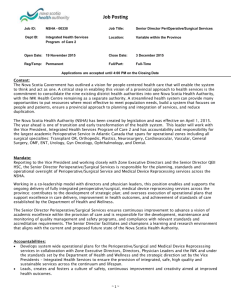Higher level training optional unit: Perioperative medicine
advertisement

Higher level training optional unit: Perioperative medicine Learning outcomes Undertake pre-operative evidence-based risk assessment. Learn about techniques to reduce perioperative risk and optimise cardiovascular and respiratory comorbidities Analyse the principals of perioperative fluid monitoring and management in large case surgery. Understand the research methods used and critically appraise key studies in perioperative medicine Core clinical learning outcomes Demonstrates the ability to provide safe and effective perioperative anaesthetic care to high risk emergency surgical cases from surgical decision to discharge from level 3 care. Apply risk-assessment tools in preoperative assessment to qualify patients’ perioperative risk Knowledge Outline the physiological pathways involved in the stress response to surgery and the surgical insult. Outline the principals underpinning CPEX testing, its interpretation and evidence base Understand how abnormalities of perioperative investigations (including CPEX testing) will affect perioperative management. Understand the key principals behind risk assessment in relation to cardiac and respiratory disease Outline the principals behind enhanced recovery Recognise the function of the Post Anaesthetic Care Unit Understand the role and remit of NCEPOD Skills Participate in a surgical outpatient clinic to gain an understanding of the barriers to pre-habilitation Demonstrates effective contribution to surgical decision making including the risk / benefits of surgery and futility issues Participate in cardiac and respiratory outpatient clinics to gain an understanding of how to optimise a wide range of co-morbidities Manage and risk stratify a complex patient at pre-assessment clinic. Use pre-operative risk stratification tools to identify patients’ surgical risk, for example, P-Possum Observe CPEX testing to ensure patient safety and produce valid results. Learn skills in perioperative CPEX interpretation (Identify AT, VO2 peak, oxygen pulse and VE/VCO2) Demonstrates safe and effective perioperative anaesthetic care to patients of all ASA grades requiring major intra-abdominal surgery Demonstrate the ability to use and interpret a variety of methods cardiac output monitors (e.g. oesophageal Doppler and Lidco) and understand their limitations Demonstrates the ability to be an effective member of a multi-disciplinary team managing elective general surgery lists safely and effectively. This implies demonstrating essential generic communication, teamwork, leadership and professional skills, as well as those specific to the perioperative anaesthetic care of the patients Demonstrate the ability to manage a complex post-surgical patient in a level 2 or 3 setting. Critically appraise the key papers with regards to perioperative medicine. Assess the major studies relating to perioperative fluid therapy and management and goal directed therapy. Argue the case for and against the perioperative use of crystalloids and colloids including starches.



